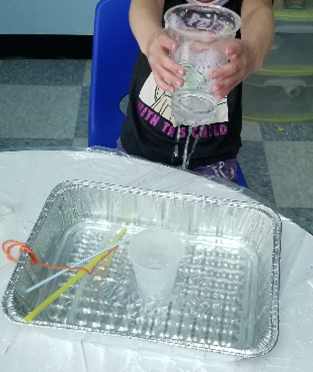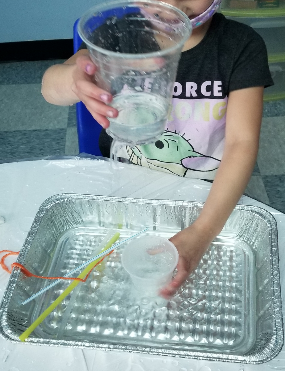Water Works!
Developed by Karen Mangone , PCM Play Intensive 2021
(FOCUS: PreK – K, Language & Literacy, Science, Exploration and Design Thinking, Mathematics, Social & Emotional Learning)
Students will experiment with water and find different ways to direct and deliver this precious resource to help plants grow. Using recycled materials, students will design water delivery systems that help control and conserve water.
Students are using water play mixed with experimentation using different plastic containers and tubes to solve a real world problem: How do you direct the flow of water to the roots of a plant to help it grow? How do you slow down the flow of water so that less water will be used?
Students are not only learning to make decisions to problem solve, they are also testing their solutions to see what works or does not work. They are learning how to be innovative and critical thinkers who value their own ideas and those of others.
Materials
- Plastic tablecloths or garbage bags cut to fit student desks or work areas
- Dollar store aluminum pans to catch and contain water, plastic cups to refill containers.
- Yarn
- Coffee filters
- Duct tape
- Recycled small plastic containers or tubes (ex. plastic water bottles with caps, containers with covers, tubes or straws) that have been cleaned
- Recycled plastic water or milk jugs (½ gallon or gallon)
- Timers or stop watches *not required
- *For use by the teacher only!* Scissors, barbeque fork or corkscrew (for poking holes in the plastic containers)
Set Up
- Fill plastic water/milk jugs with water and have them ready.
- Student desks or tables for experimenting are cleared and covered with tablecloths or garbage bags for quick clean up and protection.
- Put supplies for creating water delivery systems (plastic containers, bottles, straws, tubes, yarn, coffee filters, duct tape, etc.) on a table or tables.
- Show students how to use timers or stopwatches if using them.
Student’s Job
Students will make a water delivery system reusing recyclable materials that will deliver water to the roots of their plants by conserving water and slowing down the rate of delivery.
How can you make a water delivery system that will deliver water to the roots of your plant and deliver it slowly?
How fast is the water flowing? Can you conserve the water and slow it down?
Target the water to flow out of the bottom of the container or the top of the container?
- First each environmental scientist/inventor will think about what they could design to deliver water to the roots of their plants.
- Next, they will go to the table of recycled or reusable materials and select the items that they think they will need.
- Then, they will put water in their chosen containers and experiment with different materials and find ways that they can deliver water directly to the plant’s roots in a slow manner, not overwatering the plant.
- These environmental scientists will share their thoughts and designs with the whole group.
- Students will think of ways that they can change and improve their designs based upon experimentation and peer/teacher suggestions.
Further Challenges:
Finally, students will test their inventions or designs using plants inside the classroom or outside in a garden.
Students can also find a way to connect their individual water delivery systems to the others to build a giant aqueduct system!
Teacher’s Job
Standards Alignment
Language & Literacy
CCSS.ELA-LITERACY.LANGUAGE.K.5.C: Identify real-life connections between words and their use.
CCSS.ELA-LITERACY.LANGUAGE.K.5.D: Distinguish shades of meaning among verbs describing the same general action (e.g., walk, march, strut, prance) by acting out the meanings.
CCSS.ELA-LITERACY.LANGUAGE.K.6: Use words and phrases acquired through conversations, reading and being read to, and responding to texts.
WIDA-ENGLISH LANGUAGE DEVELOPMENT STANDARDS
Language for Social and Instructional Purposes: English language learners communicate for social and instructional purposes within the school setting.
Language for Language Arts: English language learners communicate information, ideas and concepts necessary for academic success in the content area of language arts.
Language for Science: English language learners communicate information, ideas and concepts necessary for academic success in the content area of science.
NEXT GENERATION SCIENCE STANDARDS: ENGINEERING, TECHNOLOGY, AND APPLICATIONS OF SCIENCE
K-2-ETS1-1: Ask questions, make observations, and gather information about a situation people want to change to define a simple problem that can be solved through the development of a new or improved object or tool.
K-2-ETS1-2: Develop a simple sketch, drawing, or physical model to illustrate how the shape of an object helps it function as needed to solve a given problem.
K-2-ETS1-3: Analyze data from tests of two objects designed to solve the same problem to compare the strengths and weaknesses of how each performs.
NEXT GENERATION SCIENCE STANDARDS: EARTH AND HUMAN ACTIVITY
K-ESS3-1: Use a model to represent the relationship between the needs of different plants and animals (including humans) and the places they live.
K-ESS3-3: Communicate solutions that will reduce the impact of humans on the land, air, water, and/or other things in the local environment.
Connect to Previous Work
This lesson can be connected to a unit on Earth Science and Social Studies on being a responsible citizen and taking care of the environment. It can also be used as a STEM activity because it shows problem solving using innovation with the use of science, technology, design engineering, and math.
Boston Program: Unit 4 Our Earth.
Kindergarten – Focus of Early Learning (www.pbsearlylearning.org).
Include in the middle of Unit 4: Week 4: In this unit students will be learning about Reducing, Reusing, Recycling and being caretakers of our Earth.
Read aloud: Unit Text: “Recycle!” by Gail Gibbons
Prepare/ Background Info
Students have been given background knowledge about how plants grow, the function of roots and stems, and the importance of water as an essential resource on this planet that helps plants and animals to survive and grow.
Read Alouds providing background knowledge: “From Seed to Plant” by Gail Gibbons, “How a Seed Grows” by Jordan/Krupinski, and “A Cool Drink of WATER” by Barbara Kerley.
Essential Question: What do plants need to grow?
Students will understand that plants need water to grow.
VOCABULARY: water, flow, pour, drip, deliver, tube, straw, containers, bottles
MLL Students will learn 3-5 vocabulary words
If needed use Spanish translations for keywords:
Examples: reducir-reutilizar-reciclar
Boston Program Vocab: reduce, reuse, recycle, conserve, solution
*innovation – thinking of new ideas
Extend/ Take it Further
- What recyclable materials did you use?
- How are you reusing that water bottle or straw?
- Students will learn how much water their plants need to grow by testing the soil to see if it is dry or moist.
- Students will build upon their learning as they test and continue to test their innovative water delivery systems with their plants or gardens.
- Results can be recorded in a “Plant Watering Diary”.
Facilitation Strategies
After setting up the experiment area (tablecloths and aluminum pans) give the students time to select the items they would like to start with
Give them freedom to explore water and how it flows in and out of the containers. Then, ask them what changes they could make to that container to make the water flow more slowly, conserving the water and delivering it in a better way to the roots of a plant. Ask questions to get them thinking of the functions of tubes, straws, yarn, holes (such as strainers, sprays).
Ask students how to get the water out of the container from the bottom or the top. Allow the students to think of solutions and innovations on their own. The teacher can lend a hand helping the student but not giving them the solutions.
Students can return to the materials tables as needed.
*The students must ask the teacher for help with tape, scissors, or the making of holes as it is dangerous and difficult..
*Caution the students to keep the water in their aluminum pans and to reuse the water they were given using the plastic cups.
Teacher takes notes and asks students questions as they are exploring, designing, and problem solving. Teacher can take pictures of student inventions and label them for future use. Record students giving descriptions and telling how their water delivery system works.
*At the end set a good example of reusing, recycling, and reducing by keeping all items and using them again in the class.
Play to Notice
Experiential: Hands-ons experimentation with water and its properties, and recyclable and reusable materials and their properties.
Physical: Children are using their hands to move and manipulate items (plastic containers & tubes) so that they can function for a purpose.
Social: Communications and interactions with the other students trying to do the same thing.
Emotional: Frustration of something difficult or not working or elation of discovery or success.
Dynamic: Students push their own boundaries, come up with innovative ideas, and master new skills.
Questions to Ask:
- What recycling items are you using?
- How are you doing?
- Are you having any problems slowing the water down?
- How are you going to get the water to the plant roots?
- How did you solve your problem?
- Do you need any help with anything?
- What worked or what didn’t work? Why?
- How did you feel doing this experiment?
Content Matter to Notice
Students are learning how to use what they know and to apply it to solve a water delivery and conservation problem. They are learning how to be risk takers and innovators by thinking of new ways to do something (water plants). They are stretching their thinking to make changes or improvements to their designs.
Notice if the students are using the vocabulary from the read alouds or unit vocabulary in their conversations. Teachers should use the content vocabulary words when asking the students questions.
Are connections being made from the read alouds to their “real” experience of recycling and reusing items to conserve and find solutions to help our earth?
SEL to Notice
Are the students enjoying this activity? Are there any students who do not like working with water or any of the other materials?
How do they feel about solving a problem that is a “real” life problem and will impact the outcome of their plants growth?
Let students know that it is OK to make mistakes because we learn valuable information. We are all learning and trying to find better ideas or solutions
Students can also have different solutions and ideas that solve the same problem differently.



0 Comments